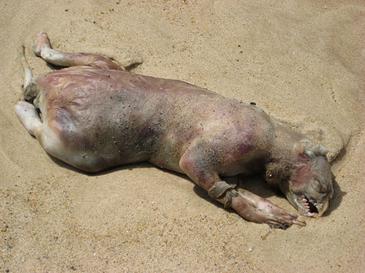Sunday, March 9, 2014
The Montauk Monster
In 2008, shortly after BeastPedia began its five-year hiatus, a strange carcass washed up near Montauk, NY. It was clearly a decaying mammal, with visible paws and patches of grey hair. But what exactly was it? Photographs of the beast, circulated on the internet, caused rampant speculation. Some thought the creature an alien, some thought it a cryptid, and some thought it a genetic experiment. An animal research center, they pointed out, was only a few miles away. What if one of the subjects had escaped?
The creature, as it turned out, was nothing so exotic. It was a decomposing raccoon, rendered near-unrecognizable by the forces of the tides. Several posts ago, I mentioned taphonomy -- the study of how living things decay. This is another mystery solved by that useful science. Let's look at the carcass in detail, examining it step by step, until we can bring the "monster" back to life.
First of all, we know this creature was a mammal. There are patches of fur clinging to its hide, which clearly isn't reptilian. A second photo shows visible testicles, and the creature's dentition is visibly mammal-like. So are its ears, its toes, the position of its legs, and virtually everything else we can see. How big was it? A fly on the carcass' back gives us a sense of scale -- and tells us it was about the size of a dog.
Thus far, we know we're dealing with a mid-sized North American mammal -- and a carnivore, based on the shape of the teeth. This leaves us only a few options, including dogs, cats and raccoons. The Montauk Monster looks like none of these -- but only because it's decomposed. When a body floats in water, it rapidly bloats and begins to lose its hair. That's what has happened here, and what makes the creature look so deformed. The second thing to decompose is the snout -- which contains plenty of soft tissues. When these fall apart, the premaxillary bones are exposed, producing the monster's "beak."
What identifies the Montauk Monster as a raccoon (as opposed to a dog or cat) is the shape of its teeth. All families of mammals have fairly unique dentition, which can be told apart by an expert. Skull shape is a major indicator of taxonomy, and to a mammalogist, this carcass screams "raccoon."
Read more about the Montauk Monster:
http://scienceblogs.com/tetrapodzoology/2008/08/04/the-montauk-monster/
http://nymag.com/daily/intelligencer/2008/07/the_monster_of_montauk.html
Image (public domain) from http://upload.wikimedia.org/wikipedia/en/8/8f/RhodeislandMonster.jpg
Subscribe to:
Post Comments (Atom)

No comments:
Post a Comment